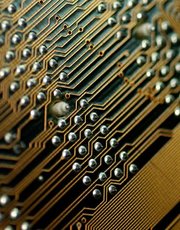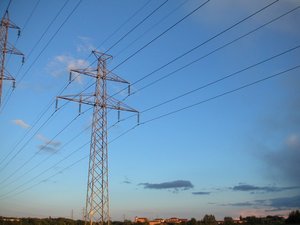Electrical engineering
|
|
Electrical engineering is an engineering discipline that deals with the study and application of electricity and electromagnetism. Its practitioners are called electrical engineers. Electrical engineering is a broad field that encompasses many subfields including those that deal with power, control systems, electronics and telecommunications.
| Contents |
History
Electrical engineering as a professional discipline advanced rapidly in parallel with the growing applications of electrical technology for power, communication, and later, computation. By 1890 several institutions in the United States and Canada offered degree programs in electrical engineering. Masters and doctorate programs in electrical engineering were not common until well into the 20th century. Previously electrical studies had been part of the mechanical program, or affiliated with the department of physics.
Thomas_Edison,_1878.jpg
MIT offered the first course in electrical engineering in the U.S. in 1882. This course was organized by Professor Charles R. Cross who was head of the Physics department, and who later became a founder of the American Institute of Electrical Engineers which later became the Institute of Electrical and Electronics Engineers. In 1886 the University of Missouri established the first department of electrical engineering in the U.S. Template:Ref
Even in the early days of engineering education, conflicts existed between education directed toward practical hands-on skills and application of mathematical and physical theory. This range of opportunities persists to this day; someone educated as an electrical engineer may be found supervising electricians in an industrial plant or may be researching fundamental problems in semiconductor physics or mathematical analysis.
Applied mathematics proved well-suited to the practical problems of electrical engineering, and engineers developed some mathematical techniques applicable to other disciplines (such as Oliver Heaviside's formulation of Maxwell's Equations in the modern vector form).
An early example of the application of mathematics to electrical engineering arose in 1883 when Thomas Edison's company undertook the installation of an overhead electrical distribution in Sunbury, Pennsylvania. To establish the most economic wire size for the distribution system that Edison had a miniature model laboriously constructed, with each customer's load modelled by turns of resistance wire. Miniature models of feeders and branch circuits were constructed, and tested with various wire sizes until a satisfactory size was found. An engineer working for Edison, Frank Sprague, demonstrated to Edison that the proper sizes could be calculated mathematically in a single afternoon. Template:Ref
Theories, tools and work
The types of work electrical engineers do is diverse. Many work on the integration of discrete electrical components with the aim of designing systems or devices that fulfil a particular purpose. Others may work on the design of individual electrical components, the operation and maintenance of such systems or the processes behind the manufacturing of such devices.
The sciences of mathematics and physics are fundamental to electrical engineering as they help to obtain both a quantitative and qualitative description of how such systems will work. Today most engineering work involves the use of computers and it is commonplace to use CAD programs to design electrical systems.
Particular theories employed by electrical engineers include fourier theory, control theory and statistics as well as electromagnetism, quantum theory and solid state physics. Particular electrical components include generators, transmission lines, integrated circuits, resistors, capacitors and inductors.
Subfields
Although electrical engineering has many subfields, they all center around electromagnetism. Some work on the distribution of electrical power; some on the design of electronic devices and some on the transmission of information. Most of these subfields directly interface with computers. For example, power engineering is increasingly relying on computers for the distribution, accounting and control of power.
Power
Power engineering is a subfield of electrical engineering that deals with electricity generation, transmission and distribution. These three areas make up a power grid that is used to provide industry, commerce and residents with electrical power.
Today, most power distribution is done using an alternating current with many grids choosing to adopt three-phase electric power. The power is then split before it reaches residential customers whose low-power appliances generally rely upon single-phase electric power. Many industries prefer to receive three-phase power though because it allows them to drive electric motors with greater efficiency. High-voltage direct current may be used for long distance transmission or interconnections between grids.
Many sites will also chose to have their own generators to either complement or replace power from the main grid. Hospitals often have such systems in case of a power outage and some industries, especially those in remote areas, may find it more economical to generate their own power.
Transformers play an important role in power transmission because they allow power to be converted to and from higher voltages. This is important because higher voltages suffer less power loss during transmission. Electrical substations exist throughout grids to convert power to high voltages before transmission and to low voltages suitable for appliances after transmission.
As well as the design of such systems, a key focus of power engineering is the operation of such systems. Since electric power cannot be efficiently stored, power engineers must also make sure that the power supply closely matches the demand. This can be achieved through mathematical modelling. If a grid is undersupplied users may experience brownouts or blackouts.
Control systems

Control engineering is the engineering discipline that focuses on the modelling of a diverse range of dynamic systems and the design of controllers that will cause these systems to behave in the desired manner. Although such controllers need not be electrical many are and hence control engineering is often viewed as a subfield of electrical engineering.
Electrical circuits, digital signal processors and microcontrollers can all be used to implement control systems. Control engineering has a wide range of applications from the flight and propulsion systems of commercial airliners to the cruise control present in many modern automobiles.
Control engineers often utilize feedback when designing control systems. For example, in an automobile with cruise control the vehicle's speed is continuously monitored and fed back to the system which adjusts the motor's speed accordingly. Where there is regular feedback, control theory can be used to determine how the system responds to such feedback. In practically all such systems stability is important and control theory can help ensure stability is achieved.
Although feedback is an important aspect of control engineering, control engineers may also work on the control of systems without feedback. This is known as open loop control. A classic example of open loop control is a washing machine that runs through a pre-determined cycle without the use of sensors. Control engineers may also play an important part in determining how users will interact with their systems.
Electronics

In the subfield of electronic engineering, engineers design and test electrical networks (more commonly known as circuits) that take advantage of the electromagnetic properties of electrical components such as resistors, capacitors, inductors, transistors, diodes and semiconductors to achieve the desired functionality. One of several ubiquitous examples is the tuner circuit, which allows the user of a radio to filter out all but a single station, corresponding to a desired signal frequency.
Electronics is often considered to have begun when Lee De Forest invented the audion in 1907 (also known as a triode vacuum tube). Within 10 years, the audion was used by radio transmitters and receivers as well as systems for long distance telephone calls. Vacuum tubes remained the preferred amplifying device for 40 years, until researchers working for William Shockley at Bell Labs invented the transistor in 1947. In the following years, transistors made small portable radios, or transistor radios, possible as well as allowing more powerful mainframe computers to be built. Transistors were cooler, smaller and required lower voltages than vacuum tubes.
Before the invention of the integrated circuit in 1959, electronic circuits were constructed from discrete components that could be manipulated by hand. These non-integrated circuits consumed much space and electrical power, were prone to failure and were limited in speed although they are still common in simple applications. By contrast, integrated circuits packed a large number - often millions - of tiny electrical components, mainly transistors, into a small chip around the size of a coin. This allowed for the powerful computers and other electrical devices we see today.
In designing an integrated circuit, electrical engineers first construct circuit schematics that specify electrical components and describe the interconnections among them. When the schematics are completed, VLSI engineers convert the schematics into actual layouts, which map the layers of various conductor and semiconductor materials on a scale of micrometres and nanometres. The conversion from schematics to layouts can be done by computer programs, although very often human fine-tuning is desirable to decrease space and power consumption.
The physical fabrication of integrated circuits is itself a huge subfield of electrical engineering, on which circuit designers must rely. As transistors become smaller microelectronic circuit designers must involve themselves more and more in the fabrication process (see photolithography).
Today, software is essential in the design process of electronic circuits, especially integrated circuits (see SPICE or electronic design automation). To this end, models of semiconductor materials and electrical components are constructed by fabrication plants and manufacturers of electrical components for the purpose of computer simulation.
Integrated circuits and other electrical components are then combined onto printed circuit boards (PCBs). Today, PCBs are found in most electronic devices including televisions, computers and audio players.
Telecommunications
Milstar.jpg
Telecommunications engineering is a subfield of electrical engineering that focuses on the transmission of information across a channel such as a coax cable, optical fiber or free space.
Transmissions can either use an analog signal, in which case the signal is varied continuously according to the information, or a digital signal, in which case the signal is varied according to a series of discrete values representing the information.
For transmissions across free space it is necessary to encode the information in a carrier signal in order to shift the information to a carrier frequency suitable for transmission, this is known as modulation. Popular analog modulation techniques include amplitude modulation and frequency modulation where the amplitude or frequency of the carrier signal (usually a sine wave) is varied according to the information. The digital equivalents of these techniques are amplitude-shift keying and frequency-shift keying. There are also more sophisticated modulation techniques including vestigial sideband modulation (used for analog television broadcasts) and coded orthogonal frequency division multiplexing (used for digital television broadcasts outside the United States and Canada). The choice of modulation can affect the performance of a system and therefore must be carefully balanced with the economic and technical requirements of the system. For digital cable transmissions, modulation may not be necessary however an appropriate line code may be. For digital systems in either case, the method of channel coding must be considered by the engineer. Channel coding allows for both error-correction and error-detection and hence facilitates the design of robust digital systems.
Once transmission characteristics of a system are determined, telecommunication engineers design the transmitters and receivers needed for such systems. These two are sometimes combined to form a two-way communication device known as a transceiver. A good example of a transceiver is a mobile phone. A key consideration in the design of transmitters is their power consumption as this is closely related to their signal strength. If the signal strength of a transmitter is insufficient the signal's information will be corrupted by noise. Telecommunication engineers may also involve themselves in the design of repeaters as well as network switches and routers.
Finally, telecommunication engineers often play an important role in the overall design and implementation of communication systems. This may include determining the optimal placement of radio masts and towers, determining the arrangement of elements in a computer network or determining the required strength of transmitters.
Computers
Xbox_console.jpg
Computer engineering is a subfield of electrical engineering that deals with the design of computers and computer systems. This may involve the design of new hardware, the design of PDAs or the use of computers to control an industrial plant. Computer engineers may also work on a system's software. However the design of complex software systems is often the domain of software engineering, which is usually considered a separate discipline.
Computer engineers typically have a sound understanding of digital systems theory and computer architecture as well as an understanding of VLSI, computer networks and computer science. In this sense computer engineers are qualified to work on a wide variety of digital systems not just computers.
Desktop computers represent a tiny fraction of the devices a computer engineer might work on as today computer-like architectures are found in a range devices include video game consoles and DVD players.
Digital signal processing
Digital signal processing (DSP) is a field mixed with computer engineering to process and manipulate signals. The signals can be any electrical signal from audio (see Audio signal processing) to voltages to images (see Digital image processing). Utilizing the flexibility of digital computers, DSP is typically performed in software but could easily be performed in hardware through the use of field-programmable gate arrays (FPGAs) or application-specific integrated circuits (ASICs) or other programmable hardware devices.
One important concern in DSP is sampling where analog-to-digital conversion and digital-to-analog conversion are used to interface the "digital world" with the real world.
DSP has become a very important field for instrumentation and telecommunications that often use statistical properties of the signal to enhance the signal. Location finding of cellular phone users has become an issue when dialing an emergency telephone number such as 9-1-1 in the US/Canada. With cellular phones, by their nature of being mobile, the user could be in an unfamiliar area and thus unable to give a location (See triangulation and GPS.
Instrumentation engineering
Another subfield is accurate measurement of electrical properties. For example, the oscilloscope is used to measure voltage. Measuring an electrical circuit inevitably changes the voltages and currents in it. The objective is to minimize the influence of the measuring circuit or even compensate for it. The field also includes sensors that use a material's electrical properties, or electromechanical means of measurement. Examples of the former are piezoelectricity for measuring pressure and temperature-dependent resistors for measuring temperature.
These sensors can be used in control engineering to sense the environment and make control decisions through electric motors and actuators.
Broadcasting
Broadcast engineering combines several aspects of electrical engineering, including telecommunications, radio frequency, audio, video (television), and computers. Audio engineering combines electrical engineering with the physics of acoustics.
Major applications
- Biotechnology such as EEG, ECG, and EKG, various other monitoring equipment as well as automated intravenous drug/serum flow control, life support systems, etc.
- Electronics: integrated circuit, computer, electronic amplifier
- Power engineering: electrical generators, electric power transmission
- Telecommunication: television, radio, mobile phone
- Control engineering: auto pilot, cruise control, climate control, space exploration, smart bomb
- Signal processing: electronic filter, digital filter, video and audio codec, radar, sonar, beamforming
Of course, everything is really a product of multiple subfields.
Professional organizations
The Institute of Electrical and Electronics Engineers (IEEE) and the Institution of Electrical Engineers (IEE) are prominent non-profit organizations for electrical engineers that publish standards, publications and periodicals and organize conferences and workshops. The IEEE is the largest professional organization in the world.
Related disciplines
Progressive miniaturisation in the production of electrical networks using semiconductor device fabrication has led to the development of complete systems on a single chip, a process called very-large-scale integration (VLSI). Microprocessors are a result of this evolution. This subfield spawned the related discipline of computer engineering.
Electronics that deal with both electrons (electricity) and light are also called optoelectronics. The related field of fibre optics has led to the development of fast telecommunication systems and the expansion of the Internet.
On the boundary of mechanical engineering and electrical engineering, mechatronics push the boundaries of what mechanical components can do and their integration with electronics. For example, the precise positioning of the laser in a compact disc player to follow a track is only possible due to electronics designed to compensate for the vibrations, the loss of focus, the irregularities in the disc, etc.
References
See also
- List of electrical engineering topics
- List of electrical engineers
- Electronic design automation
- Computer engineering
External links
- History of the IEEE Electrical Engineering Professional Society at its website (http://www.ieee.org/portal/site/mainsite/menuitem.818c0c39e85ef176fb2275875bac26c8/index.jsp?&pName=corp_level1&path=about/whatis&file=index.xml&xsl=generic.xsl)
- All About Circuits (http://www.allaboutcircuits.com) Learn the nuts and bolts about building electrical circuits, and to build appliances based on electrical circuits
| Major fields of technology | Edit (https://academickids.com:443/encyclopedia/index.php?title=Template:Technology-footer&action=edit) |
|---|---|
| Biomedical engineering | Biotechnology | Computer Science technology | Electrical engineering | Electronics | Energy | Energy storage | Gaming | Information technology | Machinery | Metallurgy | Microtechnology | Mining | Nanotechnology | Nuclear technology | Space technology | Telecommunication | Transport | Visual technology | Weapons technology | |
bn:তড়িত্ প্রকৌশল ca:Enginyeria electrònica de:Elektrotechnik es:Ingeniería eléctrica et:Elektrotehnika fr:Électrotechnique fy:Elektrotechnyk hr:Elektrotehnika it:Ingegneria elettronica lt:Elektrotechnika nl:Elektrotechniek ja:電気工学 nds:Elektrotechnik pl:Inżynieria elektryczna pt:Engenharia eléctrica sl:elektrotehnika sr:Електротехника th:วิศวกรรมไฟฟ้า tr:Elektronik Mühendisliği zh:电子工程


